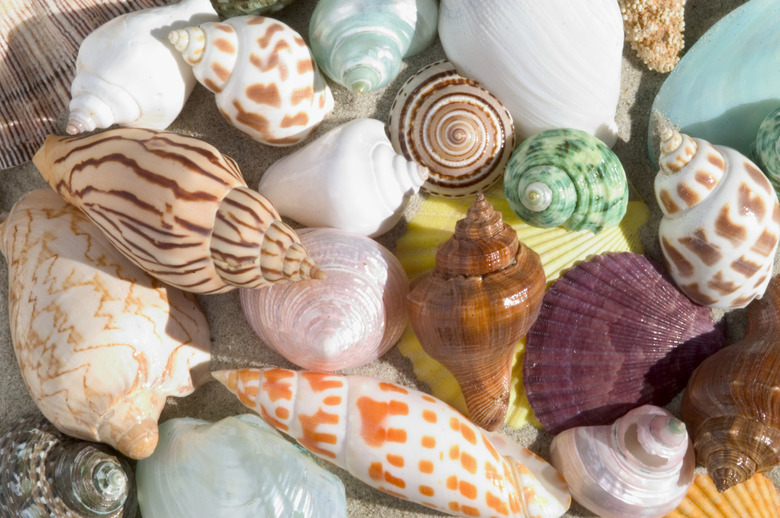How Are Seashells Formed?
Seashells are more than beautiful ornaments you see scattered along the beach. They were actually once home to various mollusks (invertebrate animals) like snails, clams and oysters. The seashells are the exoskeletons, or outer skeletons of these small, slimy creatures.
TL;DR (Too Long; Didn't Read)
The seashells you see on the beach were once home to a wide range of creatures like snails and clams. These creatures use salt and chemicals from sea water to form their hard outer shells, and discard the shells when they die.
Homes for Mollusks
Homes for Mollusks
Mollusks like snails and clams have very delicate bodies, so they need protection from the elements and predators. As mollusks develop in the sea, their mantle tissue absorbs salt and chemicals. They secrete calcium carbonate, which hardens on the outside of their bodies, creating a hard shell. The shell stays attached to the mollusk but it is not actually part of its living body because it is made of minerals, not mollusk cells (unlike most animal structures). The mollusk continues to take in salt and chemicals from the sea and secrete calcium carbonate, which makes its shell grow even bigger. When a mollusk dies it discards its shell, which eventually washes up on the shore. This is how seashells end up on the beach.
Properties of Seashells
Properties of Seashells
A seashell is made mostly of calcium, with no more than 2 percent of protein. It forms from the bottom up, creating three clear layers an uncalcified outer proteinaceous periosteum (similar to human fingernails), a calcified prismatic layer and an inner pearly calcified layer of nacre. Seashells are self-repairing; they use the calcium carbonate secretions from their mantle tissue to fix any damage. Seashells vary so much because there are lots of different kinds of mollusks, eating many different types of diets. For example, mollusks in warm tropical waters have a wider variety food sources, so they get lots of different pigments, which results in more colorful shells. On the other hand, mollusks who live in cold water have more limited food choices and tend to grow shells in more solid, dark colors.
Collecting Seashells
Collecting Seashells
Before you take a bucket of shells from a beach, consider how important they are to the planet's ecosystems. Seashells may not be home to mollusks anymore, but they can still provide shelter for algae, armor for hermit crabs and nest-building materials for birds. In most cases, it's not illegal to take seashells home (the Mexican coastline, however, is considered an environmental reserve and it's illegal to remove any of its natural items), but if you don't want to cause harm to the planet, take photographs of them instead.
Cite This Article
MLA
Gillespie, Claire. "How Are Seashells Formed?" sciencing.com, https://www.sciencing.com/how-seashells-formed-4923554/. 13 April 2018.
APA
Gillespie, Claire. (2018, April 13). How Are Seashells Formed?. sciencing.com. Retrieved from https://www.sciencing.com/how-seashells-formed-4923554/
Chicago
Gillespie, Claire. How Are Seashells Formed? last modified March 24, 2022. https://www.sciencing.com/how-seashells-formed-4923554/
